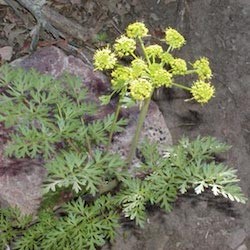
This study used evidence that suggests the dysregulation of cytokines and chemokines, including CXCL10, is the primary factor leading to poor prognosis in highly pathogenic influenza infection. This study was conducted to address the hypothesis that an aqueous extract of L. dissectum root inhibits CXCL10 secretion by human bronchial epithelial cells stimulated with polyinosinic:polycytidylic acid (poly i:c), a synthetic analog of viral dsRNA.
The study authors note that resistance of influenza A viruses to the commonly developed agents has proven problematic. They include four antiviral drugs licensed for use to treat influenza, adamantanes, adamantadin and rimantadin, and the neuraminidase inhibitors, oseltamivir and zanimivir. Since 2006, the CDC has recommended against the use of adamantanes due to resistance. Furthermore, resistance to oseltamivir between the 2007–2008 and 2008–2009 influenza seasons increased from 19.9% to 99.6%. As resistance to these antiviral medications limits their usefulness, novel treatment approaches, such as those that modulate immune responses to influenza, need to be explored.
The morbidity and mortality from highly pathogenic influenza infection is primarily caused by cytokine and chemokine dysregulation that may occur during the immune response to influenza and not by the virus itself. In recent studies of humans infected with highly pathogenic H5N1 influenza, high levels of the chemokine CXCL were correlated with poor prognosis and high viral load.
CXCL10 is a chemo-attractant for T lymphocytes, NK cells, and macrophages that express its ligand, CXCR3. High levels of CXCL10 may be responsible for excessive pulmonary macrophage infiltration.13, 14 Overproduction of CXCL10 has also been demonstrated in animal and cell culture models of influenza. Thus, therapies that target the immune response and inhibit CXCL10 production are ideal candidates for investigation.
One potential phytotherapeutic agent with ethnobotanical evidence of use in the treatment of influenza A is Lomatium 
In this study, BEAS-2B cells treated with poly i:c were exposed to L. dissectum root aqueous extract simultaneously or at 2 h intervals up to 8 h post-stimulation. Supernatants were harvested at 24 h and enzyme-linked immunosorbent assay (ELISA) performed to determine CXCL10 concentrations.
Results / L. dissectum root aqueous extract at 1 µg/mL significantly inhibited CXCL10 secretion (P=0.043, Anova, Tukey HSD) and demonstrated maximal inhibition 6 h post poly i:c exposure. MTT cytotoxicity assay results suggest that this inhibitory effect was not due to extract-induced cytotoxicity.
Conclusion / This is the first report of an inhibitory effect of an aqueous L. dissectum root extract on CXCL10 secretion, a chemokine implicated in the pathogenesis of influenza A infection. This inhibitory effect was not due to cytotoxicity of the extract on BEAS-2B cells, since L. dissectum was not cytotoxic at the concentrations that decreased CXCL10 secretion. L. dissectum significantly inhibited CXCL10 secretion when added up to 6 h post polyi:c stimulation, suggesting that aqueous L. dissectum root extract may be useful as treatment during influenza virus infection. Early and excessive production of CXCL10 is also associated with poor prognosis in other conditions such as ARDS, hepatitis, SARS-CoV infection, inflammatory bowel disease, and other autoimmune conditions.
L. dissectum warrants further investigation as a novel treatment for the prevention of influenza associated morbidity and mortality and for other diseases associated with CXCL10 dysregulation. The observation that L. dissectum extract inhibits CXCL10 secretion provides a plausible mechanism for the efficacy of L. dissectum in influenza treatment reported in ethnobotanical studies and case reports. L. dissectum may reduce morbidity and mortality associated with influenza and merits further research.
Click Here for Full Text Article





